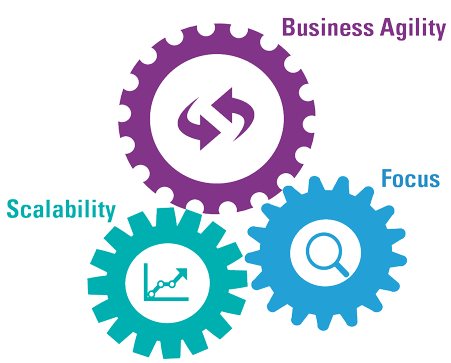The current market conditions require more agility from organizations. Customer demands are changing, and environmental uncertainties dictate scaling options. Change is continuous and – as organizations are digitizing – becoming more and more interlinked with other changes occurring at the same time. Dependencies must therefore be managed effectively, because many processes can be impacted when enacting changes. Agility has become key for survival, but also needs to be controlled. This article discusses the challenges of organizations when orchestrating change and discusses a holistic approach to do so in a way that enables digital transformation.
Introduction
Orchestrating change is as critical a business activity as ever. Recent developments with regard to the global COVID-19 outbreak have taught us a lesson. While we live in a fairly safe and secure part of the world, we can still be hit by the unexpected. What we thought was a science fiction scenario actually became reality. In addition to the impact it has had on us and our loved ones, it has also impacted our economy. Businesses had to prove their agility and resilience in adapting to this new reality.
In the meantime, technology continues to advance and digital has become part of every organization’s day-to-day operations. It is ingrained to such an extent that there are barely any processes and people left that are not impacted by it. In most cases, digital transformation can no longer be seen as an initiative with a start and end date. Once organizations have determined their digital strategy and operating model, the change does not stop. The organization will likely continue to experience a constant transformation.
This is further amplified by the connectivity of the world around us, as also illustrated by the pandemic and the connectivity within our organizations. With the rise of platform business models, it has become increasingly important to ensure that the technology within the organization is connected. In this case, we use “system” in the broadest sense of the word. Connecting the system entails “revamping” many of the organization’s legacy technology, processes and ways of working. Critical choices need to be made as to what to push forward and what to hold back. To survive, businesses need to be able to not only quickly scale up, but also be able to scale down if this is warranted by the circumstances.
These developments lead to three critical core competences that organizations need to develop and mature in, in order to successfully operate and govern the change that is required to survive.
Figure 1. Three core competences organizations need to build to survive. [Click on the image for a larger image]
This article will explore how organizations can build and apply these core competences to effectively orchestrate change. We will first introduce these three core competences in more detail, and then describe the need for these core competences in the current market and environment. We will then illustrate why many organizations are still struggling to realize value from change, followed by an introduction of our model which enables organizations to build these core competences and realize value from change. We will link the components of the model to the three core competences and come to conclusions based on their value.
Orchestrating change through three core competences
The world is currently experiencing the fourth industrial revolution, described as “a new chapter in human development ([WEF20]), enabled by extraordinary technology advances commensurate with those of the first, second and third industrial revolutions”. Digital technologies can be disruptive and cause major changes in the organization. These changes can be unplanned, difficult to understand and may pose major risks as well as major opportunities. Organizations do not have a choice whether or not to “jump on the train” as “Traditional incumbents need to embrace and adapt to these changes and re-energize their industries or they risk being outpaced by nimbler, more savvy competition” ([WEF19]). But how do you govern these changes in a way that mitigates the risk and realizes optimal business value? This can be especially challenging in established organizations, where legacy systems and processes may seem to counteract the change that is required.
Business agility
“Business Agility is the ability to compete and thrive in the digital age by quickly responding to market changes and emerging opportunities with innovative business solutions.” ([SAFe20a])
The organization needs to be flexible and operate at the speed of change. It requires agility in people, processes and technology through – among others – decoupling strategies, developing micro services, applying agile ways of working and increasing collaboration. To allow for agility in resources, it is important for organizations to collaborate with third parties to optimize business processes and minimize dependencies. Not everything needs to be developed, created and solved internally. Strategic sourcing should be up to standard to enable business agility, when organizations use multiple (third) parties.
To become more agile, more change is required. Initiatives need to be managed to achieve the desired results. This view is not new; organizations have been managing their projects and programs through portfolios for years. However, the change has now become continuous and increasingly complex. While organizations used to have projects and programs in place to implement a change – after which they would have some time before having to implement the next change – in most cases, this no longer fits today’s reality. If organizations are unable to facilitate continuous change, they may quickly become yesterday’s news. The speed and continuity of change poses another challenge in the complexity it creates. The number of changes, as well as implementation and release dates, are increasing in frequency. This means the organization cannot solely focus on new initiatives but needs to operate these right next to existing initiatives. This means for example that organizations need to operate a number of initiatives to implement new technology, while they are still rationalizing their existing (legacy) landscape. By managing these initiatives, organizations can effectively orchestrate (digital) change and increase their business agility.
Focus
Managing the change is one thing. Knowing which change to manage is another. With a multitude of choices and opportunities, it can be challenging for organizations to stay on course, while also progressing towards their goals. To realize value from continuous change, the need for a strategic mechanism grounded in the standing organization has increased. This means organizations need to create a portfolio that is aligned with the organization’s strategy, realizes value and mitigates risk. It also means that organizations need to remain critical towards initiatives that are – or are not (sufficiently) – supporting their digital strategy and changing environment. Failing can be as important as succeeding in this case. Under one condition: fail fast. Effective portfolio management will ensure that the information required to make these choices is available as and when it is needed. It will also ensure that while the organization is operating many initiatives at the same time, likely with different purposes such as maintenance vs. innovation, these initiatives support each other and do not work against each other. It will ensure integrated governance and value contribution to the organization with focus on its strategic goals.
Scalability
While business agility encompasses responsiveness to changes in market demand, there is one aspect of it that has become a significant driver for success or failure and therefore deserves to be mentioned as a separate capability: scalability. Growth in certain areas of an organization has historically had its challenges. Especially incumbents, who have relied on years of built-up technological capital know that the majority of this technology becomes outdated quickly. Legacy systems are inflexible and often incompatible with innovation-driven technology. And while technology is a major factor, we should not overlook the importance of aligning several organizational processes with the scalability that is required, e.g. resource allocation, capacity management and financial management processes.
Typically, challenges regarding scalability have focused on growth or scaling up. Following the most recent pandemic, organizations are dealing with a different challenge: how to scale down. A common response to this challenge is to restructure. This often has a drastic impact on the organization, its people and its operations, costing the organization years to get back to a somewhat normal state. As changes in the organizational environment occur more frequently, the question is whether organizations need to be able to scale, both up and down, in a faster and more flexible way to survive? Managing change through a scalable platform could be a necessity to enable accessing and continuing to service multiple market sectors, attracting and retaining talent and effectively applying technology to optimally support the organization’s strategic goals.
Why we’re still struggling to realize value from change
We’ve now described the core competences that are required for organizations to effectively operate in the current environment and be prepared for the future. The question then becomes how to build, grow and maintain these core competences in an organization. It all starts and ends with change. And to be more specific – how to orchestrate change.
To enable these core competences, processes need to be in place to manage change. Managing the organization’s change mostly takes place through portfolio management. SAFe® methodology describes the portfolio management competency as the alignment of strategy and execution by applying Lean and Systems thinking approaches to strategy and investment, funding Agile portfolio operations, and governance. This is a core competency to achieve business agility, focus and scalability. A SAFe® portfolio manages a set of development value streams for a specific business domain in an organization ([SAFe20b]).
While portfolio management has been around for a long time, the effectiveness of portfolio management processes is still suboptimal at many organizations who are struggling to realize value from change. This is often caused by their portfolio management not driving the three core competences as mentioned above. Allowing for continuous change requires a model that supports project, program and portfolio management as continuous – or at the very least – iterative efforts.
The KPMG digital orchestration model, as illustrated in Figure 2, describes six core components of digital orchestration.
Figure 2. Components of digital orchestration. [Click on the image for a larger image]
To manage change, all of these components should have a basic level of maturity in the organization. Depending on the size, complexity and ambition of the organization, different levels of maturity may be aspired. To facilitate the three core competences, certain aspects within these components require some additional attention. We will illustrate this through some common challenges we see at organizations below.
Strategy
Strategy – not technology – drives digital transformation ([Kane15]). Strategy drives change. Digital orchestration should be fueled by a (digital) strategy that provides a clear direction for the initiatives. However, in practice this is not always the case. Quite often, we see that there is no alignment, or worse, misalignment between the organization’s strategy and the portfolio it is trying to execute. No alignment is usually caused by a lack of a (digital) strategy altogether. There is limited to no control at all with regard to the portfolio; and while project or program objectives may be achieved, strategic objectives are not. This means that it is imperative that strategic goals should be crystal clear. A method for doing so, is the increasing use of Objectives and Key Results (OKRs) to align the portfolio with the OKRs and make choices based on the expected objectives and their outcomes of an initiative that is part of the portfolio. In addition, public sector organizations have an additional struggle as their strategic direction tends to change with the political course that might change every election. Clear goals and objectives are not only important to support decision-making in the portfolio process, but also to manage the organization as a whole and the behavior of people who are part of it.
While agile ways of working may increase the business agility as well, it may exacerbate these issues if there is no clear strategy and direction. Effectively applying OKRs is therefore even more important. At one of our clients, the organization was moving towards a more agile way of working and stimulated low-level decision-making in the delivery process. However, there were no clear guidelines and the strategy was in a state of flux. As a result, employees simply started to select initiatives that they felt were important. While these initiatives clearly had some merit, they did not align with the organization’s goals and usurped resource capacity that endangered some of the high-priority initiatives for the organization’s strategic objectives. Focus cannot be achieved when the organization does not have a clear vision, strategy and long-term direction.
Organization and governance
The organizational governance is an important foundation to support digital orchestration. Organizational governance can be defined as a system by which an organization makes and implements decisions in pursuit of its objectives ([ASQ20]), which are realized through digital orchestration. Properly structured governance includes flexibility, formally arranged information layers and meetings organized at all levels (strategic, tactical and operational). It is common practice that the designed governance does not accommodate the different levels, be it strategical, tactical and operational or – for a more SAFe®-oriented organization – enterprise, product and team. Organizations face challenges in getting across the right information at the right level, often providing information with either too much, or not enough detail to enable effective decision-making. The quality of source data is often questionable in portfolio management. Organizations frequently struggle to pull together portfolio data, because the data from project managers is either heavily dependent on their (often) subjective input and knowledge of contextual factors, or it deviates in format from other projects and programs, making it very difficult to collate and provide an integral view on the portfolio.
The correct provision of information is essential and at this moment we encounter situations where the information is fragmented. Consequently, management is not able to make informed decisions. For a scalable, agile organization it is crucial to be able to make the right decisions on going forward or explicitly not going forward with initiatives. This decision can only be made if the right information is available.
Delivery and alignment
Alignment of the portfolio with the organization strategy and objectives is essential in identifying, assessing, selecting and eventually prioritizing projects in the portfolio. Alignment with different types of goals to support the strategy can be especially challenging, e.g. business continuity vs. modernization or innovation. This also means matching supply with demand in a portfolio. At one of our clients it was very clear that there was very short supply compared to the demand coming from the organization. When this happens, it frustrates the process and the system in which it operates. Maintaining a balance between what you want to achieve as an organization and what you can achieve is crucial. Stringent prioritization is a key process to support this balance. It needs to take into account many factors, with dependencies being one of the main ones. Value optimization can only be achieved if dependencies between initiatives are identified and planned for accordingly. This needs to be a factor when determining priorities as well.
To ensure the alignment of the portfolio with the strategy and effectively perform prioritization, the processes and information within the portfolio need to be aligned as well. This kind of alignment can ensure the right information is available to determine the priorities, allowing focus to be applied to the portfolio. This especially applies for larger, more complex portfolios spanning multiple business units, teams and/or delivery organizations. Managing dependencies in turn also manages flexibility and can exponentially increase the value of the portfolio.
Prioritization is an important instrument to enable focus and allow for scalability in the portfolio. Scalability is based on effective decision-making on both continuing and discontinuing initiatives in the portfolio. This requires unambiguous, uniform standards and definitions in the orchestration process. When developing these standards, it is important to reconfirm the organization’s strategy. Unambiguous standards and embedded ways of working not only benefit the decision-making process, but also enhance collaboration between different teams and stakeholders. This allows for more effective use of multi-disciplinary teams, increased knowledge sharing and extended resource core competences. In turn, it enables resource re-allocation in case of downscaling, as well as increasing resource levels when upscaling.
People
Organizational culture is reflected in its employees. It expresses goals through values and beliefs and guides activity through shared assumptions and group norms ([Groy18]). Culture plays a crucial role in adopting new ways of working and technologies ([Cabr01]). Experience shows us that companies in different industries struggle with the fact that human beings tend to be hesitant when it comes to change. We’re creatures of habit, whether we like it or not. Because processes and technology within organizations are becoming more connected, our ways of working are also affected. The request from management is often to align these ways of working, if only to allow for effective decision-making as highlighted earlier. Often, these steps result in resistance as people have had their own “way of doing things” for a long time. And while the benefit of change to one might be minimal (or even negative), the benefit to all could be great. While this can be hard on individuals, it is essential to ensure some level of standardization is embedded in the organization.
In addition to people actively working on the portfolio, there are usually many other stakeholders involved. We frequently see that stakeholder management is still performed in an informal way, and no formal and structured communication plan is followed. Moreover, we see that an overview of stakeholders is missing, which makes it difficult for organizations to know who should be involved. Also, stakeholders are present at different levels which requires different types of communication, different cadences in communication and presentable information and reporting on the desired level. While this all sounds straightforward and everyone understands the concepts of stakeholder management, in our experience this is still the most underestimated component of digital orchestration. It is also one of the most critical success factors.
If the portfolio reaches a significant size, there is a point where change becomes the new normal for employees, meaning that the organization culture should also fit this mindset. When organizations come from a situation where continuity and stability were valued most for example, interventions in the process will likely be unavoidable to enable movement in a different direction.
Technology
While technology is often part of a large number of initiatives in the portfolio, it can also support the digital orchestration processes. Jira is a tool which is widely used for software development but can also be used to support project monitoring using Kanban boards or sprints. Another tool still frequently used for (progress) monitoring and reporting is (unfortunately) Excel. We often see difficulties arise with regard to the need for information and the way to present this information while – for example – Jira can support these data and information requests when the tool is properly systematized (i.e. Portfolio for Jira 3.0). Ultimately, the tooling used should fit the digital orchestration processes and scope and should also be user-friendly for employees (reduce administration, provide ease of user interfacing, etc.). Overall, a multitude of solutions is available, e.g. ServiceNow, CA, BMC, depending on the size of the organization. At one of our clients the tooling had not quite grown with the organization’s needs. Separate tooling was used for project management (Clarizen), while portfolio management took place in Excel, and funding processes were entirely managed outside of both of these tools. This required a large administrative process since manual updates were necessary in all tools meaning duplicate efforts, risk of incorrect or incomplete data and no single source of truth.
The degree to which the software development process is automated is very important to realize speed and flexibility in delivery. This is not yet widely applied in organizations. Concepts like CI/CD (Continuous Integration / Continuous Deployment) create possibilities to not only facilitate the speed of development but also increase quality, limit rework and allow for a fairly swift move of products into production ([Brum19]). We do see that the importance of architecture and the development of platforms is recognized more in enabling change as well. Enterprise architecture and scalable platforms are critical enablers to support business agility going forward.
Control
Control can be seen as the measurable part of digital orchestration. Components of control include the management and measurement of performance, benefits, finance and capacity. A frequently heard piece of advice goes: “if you cannot measure it, you cannot manage it” ([Foro19]). Successfully managing an organization’s portfolio requires a framework which establishes clear and concise guidelines for monitoring, as well as actual monitoring processes for managing the portfolio (as it is managed and delivered).
Once organizations evolve from managing projects and programs to managing a portfolio, a common way of working becomes increasingly important. Scaling a portfolio is already hardly possible without a common, described way of working let alone controlling one. Moreover, a standardized framework, applied consistently across different teams in the organization, is required to enable scalability. Often, teams use their own guidelines and checks and balances, resulting in inconsistencies across the organization. A challenge in many organizations is that documentation supporting the portfolio is often limited, if maintained at all. With increased complexity and size of a portfolio, relying on documentation becomes a necessity, because relying on tacit knowledge is no longer feasible.
Case example: retail project on portfolio management design and implementation
One of our clients was running multiple projects simultaneously and saw an increase in demand for change. While the projects were individually successful and well-managed, the newly hired portfolio manager was unable to determine the financial status of the portfolio. The documentation at project level was incomplete and could not be aligned with different projects in terms of their spend and their capacity management. Guidelines were never formalized, so project managers all had different approaches to come to their numbers. For the portfolio manager, this meant that she was comparing apples with oranges as, for example, the budget in some cases consisted of purely the required IT resources, while others consisted of both IT and business resource requirements.
For organizations under more stringent compliance requirements, it is critical that the compliance framework as well as the compliance specialists are aware of the ambitions of the organization and are able to adapt to support the core competences that the organization aims to nourish. If business agility is a core capability that the organization wants to develop and maintain, any control framework applied should be flexible enough to allow change, speed and innovation. Risks should be addressed, but we shouldn’t hold on to existing controls if the risk can be addressed more efficiently. Compliance is generally not a choice but should be designed in a way that supports the organization’s objectives and does not counteract them.
Building the core competences through these six components
While a foundation of these six components should be in place at any organization aiming to effectively orchestrate change, build the core competences of business agility, focus and scalability, the attention should be focused on increasing the maturity of some of these components. Earlier we mentioned that some of these components affect the core competences. The overview below shows which components are in critical need of improvement.
Table 1. Building the capability to change through the six components of digital orchestration. [Click on the image for a larger image]
Business agility
Increasing your business agility requires effort across all six components. However, some focus points within these components can be identified. The strategy should be clearly communicated and embedded in the organization so that decision-making is consistent and aligned. The governance structure should allow for decision-making to be fast and of high quality. Prioritization should be a continuous process, with clear guidelines on balancing maintaining legacy systems with innovation and modernization. A culture should be in place where failure is allowed and it is accepted that some projects are cut, even when they are already halfway. Partnerships should provide a flexible environment where different directions can be chosen when needed. This should also apply to technology, where the organization’s enterprise architecture needs to aim for flexibility and tooling should be in place to quickly provide an accurate portfolio to support the decision-making process. Clear guidelines should be communicated throughout the organization for consistent operation and effective KPI monitoring. Compliance requirements have to be designed and embedded in such a way that the risk is addressed, but the impact to operations and working towards strategic goals is minimized.
Focus
To support more focus, the same clear communication regarding strategy is key. This will ensure that even with decentralized decision-making and autonomous teams, the focus on the strategic objectives remains. Critical aspects of focusing your change efforts are delivery and alignment. Ensuring that every initiative is measured against established criteria to (re)evaluate its value contribution to the organization’s strategic objectives. It also requires decisiveness when it comes to ongoing projects where this value contribution is not visible and stopping them to allow reallocation of resources to the projects that do deliver this value. Organizations with a culture that does not embrace transparency may respond negatively to any “red” in dashboards and will therefore not succeed – highlighting the issues and risks clearly is required to enable well-informed decision-making as well as learning. Applying focus cannot be done without them.
Scalability
Scalability means minimizing dependencies where possible. To put it in a simple metaphor – it is like a Jenga tower where you want to remove as many blocks as possible and add them to the top of the tower without the whole construction collapsing. To achieve this, you do not only need steady hands and decisive action, but the dependencies between the blocks should be minimized as well. The same applies to the portfolio, where you want to minimize dependencies in delivery, so that different initiatives can be easily added or removed. A fairly mature enterprise architecture would be a prerequisite in order to achieve minimal dependency.
This also applies to the technology, which should support adding or removing different components. Automated processes regarding integrity and regression testing to enable a stable and fast release management process can further enhance the capability to deploy solutions at scale.
Conclusion
Change in organizations has become an ongoing process, often including a major IT component. Digital transformation is unavoidable for many organizations and needs a plan-based, structured approach to be successful. Transformation is not contained within a single department; it requires a holistic view to ensure alignment and management of dependencies across the organization. To enable organizations to meet the demand for business agility, to scale (up or down) and to focus on key initiatives, change needs to support the organizational strategy and business objectives. It needs to be managed through an effective governance model (allowing flexibility) and should be aligned with both the vision and strategy of an organization, as well as its delivery. Change requires the right people, with the right skills and a supportive culture that stimulates agility. While technology is often the object of change, it also needs to facilitate the change process. Agile ways of working and delivery through release trains can support this. This also means that we need to approach control from a different angle, allowing flexibility while managing the critical risks and maintaining quality in key delivery processes. On a high level – the risks have not changed. But there are different, possibly higher, standards to risk management so that business processes can be executed properly. Therefore, organizations need to alter the way they address these risks, balancing it with the agility that is now required from organizations on a daily basis.
Orchestration is the driving force to effectuate digital transformations. It approaches these six components holistically to enable continuous change and meet strategic objectives.
References
[ASQ20] American Society for Quality (2020). What is Organizational or Corporate Governance? Retrieved from: https://asq.org/quality-resources/governance/
[Brum19] Brummelen, J. van & Slenders, T. (2019). Modern Software Development: It is all about quality and speed. Compact 2019/2. Retrieved from: https://www.compact.nl/articles/modern-software-development/
[Cabr01] Cabrera, Á., Cabrera, E. & Barajas, S. (2001, June). The key role of organizational culture in a multi-system view of technology-driven change. International Journal of Information Management 21(3), 245-261. Retrieved from: https://www.sciencedirect.com/science/article/abs/pii/S0268401201000135/
[Foro19] Foroohar, R. (2019). Why management by numbers doesn’t add up. Financial Times. Retrieved from: https://www.ft.com/content/2950e8ca-a489-11e9-a282-2df48f366f7d/
[Groy18] Groysberg, B. et al. (2018). The Culture Factor. Harvard Business Review, 2018(1). Retrieved from: https://hbr.org/2018/01/the-culture-factor/
[Kane15] Kane, G.C. et al. (2015, July 14). Strategy, Not Technology, Drives Digital Transformation: Becoming a Digitally Mature Enterprise. MIT Sloan Management Review. Retrieved from: https://sloanreview.mit.edu/projects/strategy-drives-digital-transformation/
[SAFe20a] SAFe® Scaled Agile. (2020). Business Agility. Retrieved from: https://www.scaledagileframework.com/business-agility/
[SAFe20b] SAFe® Scaled Agile (2020). Lean Portfolio Management. Retrieved from: https://www.scaledagileframework.com/lean-portfolio-management/
[WEF19] World Economic Forum (2019, October 4). Agile Governance for Creative Economic 4.0. Retrieved from: https://www.weforum.org/reports/agile-governance-for-creative-economy-4-0/
[WEF20] World Economic Forum (2020). Fourth Industrial Revolution. Retrieved from: https://www.weforum.org/focus/fourth-industrial-revolution/








